Stitch 'n Bitch: The Knitter's Handbook (26 page)
Read Stitch 'n Bitch: The Knitter's Handbook Online
Authors: Debbie Stoller

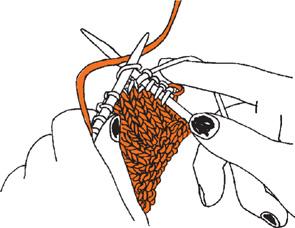
2
Bring the ball end of the yarn
around and underneath
the old color, then wrap it around the needle to make a knit (or purl) stitch. Finish the stitch in the usual way, dropping both the old loop and the tail of the new yarn over the newly formed stitch.
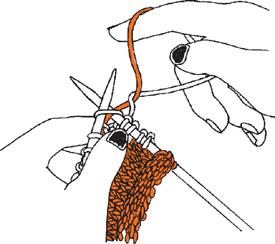
To change from one color to the next in the middle of a row:
Bring the old color up and to the left, then bring the new color up
from under
the old color, and make the new stitch. This hooks the two stitches together, like they’re standing arm in arm for all eternity. Aw, ain’t that sweet?
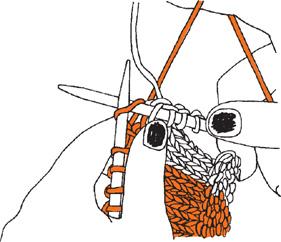
That’s it, basically. You should know that the edges of your color blocks are probably going to look crappy—the edges of intarsia always do. Just wait until you’re all done knitting, then take a little double-pointed needle and tug on the edges of each of those stitches to make ’em look nicer (see
page 109
). Also remember that the ragtag look of freshly knit intarsia patterns can be vastly improved and evened out with a bit of blocking.
And when you’re done, yes, you really do have to work away each and every one of those yarn ends. Just try, if it’s at all possible, to work each color away in an area that’s the same color—otherwise your ends may show through on the front of your work.
Let me be honest with you: I don’t especially like Fair Isle knitting. Despise it, actually. Yet quite beautiful knit fabric can be made with this technique, and I feel it is my duty to at least show you how it’s done.
Fair Isle
(also known as jacquard knitting or stranded knitting) is the technique used to knit with two colors of yarn (sometimes more) in the same row to create patterns and pictures. It’s this business of knitting with two colors at the same time that makes it so tricky. You can drop one color and pick up the other each time you need it; you can hold two different yarns in one hand; or you can hold one color of yarn in your left hand, one in your right, and knit with both at the same time. That last one is a real doozy—akin to patting yourself on the head and rubbing your tummy—but it’s the most popular method going. We’ll start with the easiest: the picking-up-and-dropping method.
GOODNESS, GRACIOUS, GREAT BALLS OF COLOR: TIPS FOR SUCCESSFUL INTARSIA
EACH AREA OF COLOR SHOULD HAVE ITS OWN BIT OF YARN
:
That means, if you are knitting a yellow block in the center of a blue background, you will be working with three lengths of yarn: one to knit the section of blue before you get to the block, one to knit the yellow block, and one to knit the blue section after the block.
SNEAK IN SOME FAIR ISLE
:
Unless you’re a balls-out purist, you will use the Fair Isle technique (see
page 93
) to knit small areas of color in your intarsia and thus have fewer pieces of yarn dangling from the back of your knitting. So don’t sweat it if you decide to carry yarn from one area in your picture—say, an eyeball—across a few stitches to knit the other eyeball. But try not to do it too often. If you have more than, say, 5 stitches between areas of color, it’s probably best to cut a new piece of yarn for each one.
LET IT ALL HANG OUT
:
Use bobbins to wind up yarn for your color areas, but for small areas of color (a nose made of 6 stitches, for example), just cut a length of yarn and let it hang loose at the back of your work.
DON’T FORGET TO BREATHE
:
More than any other knitting technique, intarsia requires an almost Zen-like composure. The multiple strands hanging off the back of your work will inevitably turn into a mass of tangles, and you’ll frequently have to stop knitting to untangle them. But hang in there, try to remain even-tempered, and the results will be worth the trouble—I can promise you that, Grasshopper.
Simple Fair Isle
1
Knit a stitch with the first color. When you need the second color, add it in as you would a new ball of yarn (see
page 92
), and knit the required number of stitches with it.
When you need the first color again, just let go of the second color, pick up the first color and bring it
underneath
the second color, and start knitting with it again.
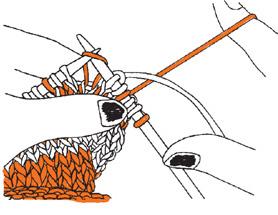
2
When you need the second color again, drop the first color, bring the second color
over
the first color, and start knitting with it.
When knitting more than an inch of stitches in only one color, you should twist that color with the color not in use about halfway through the area. Do this by carrying the yarn in use
under
then
over
the yarn not in use before making your next stitch. The next time you have to twist your yarns midstream like this, do the reverse: Carry the yarn you’re using
over
then
under
the other yarn. This will keep your balls from becoming a
big tangled mess. (Your balls of yarn, I mean.) Doing this twisting stuff serves to catch the not-in-use yarn and keeps it from forming long “floats” (the pieces of yarn that get carried behind your work). Long floats are not only unsightly but they also catch on fingers, hands, and anything else in their path.
It is very important, when carrying yarn at the back of your work, that you leave enough of it between stitches so that it lies flat but still allows the fabric to stretch. Try this: After you’ve inserted your needle into the first stitch to be knit with a new color, stretch out the stitches on the needle before you make the next stitch. As you go on knitting, stop every once in a while and stretch the fabric a bit. You won’t get quite as much stretch as you do with regular knitting, but you need to get some.
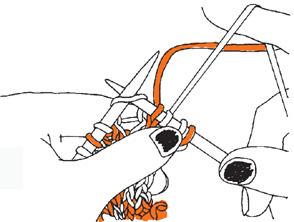
Two-Fisted Fair Isle
1
Take the main color of yarn in your right hand and hold it as you would for English knitting (see
page 34
). Take the other color in your left hand and hold it as you would for Continental knitting (see
page 36
).
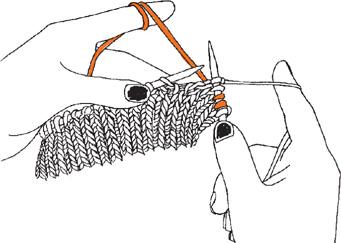
2
As each color is needed, knit it with the hand that is holding that color yarn. Be careful not to pull the yarn too tightly, as mentioned above. You will see that the yarn coming from your right hand will always be above the yarn coming from your left hand.
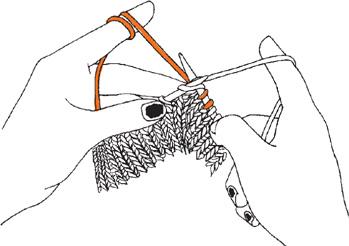
So far, so good—if you can get comfortable knitting with the yarn in both hands, and if you don’t pull the yarn too tightly.
Things get
really
interesting when you start needing to weave the yarn in order to avoid getting long floats (if you are using one color for an inch or more of stitches). Let’s start with the methods for doing this on the knit side.
To weave in yarn from the left hand on the knit side:
1
Put the needle through the next stitch as if you’re going to knit it, only don’t just yet. Bring the yarn on your left hand around the front of the right needle tip and lay it across the needle.